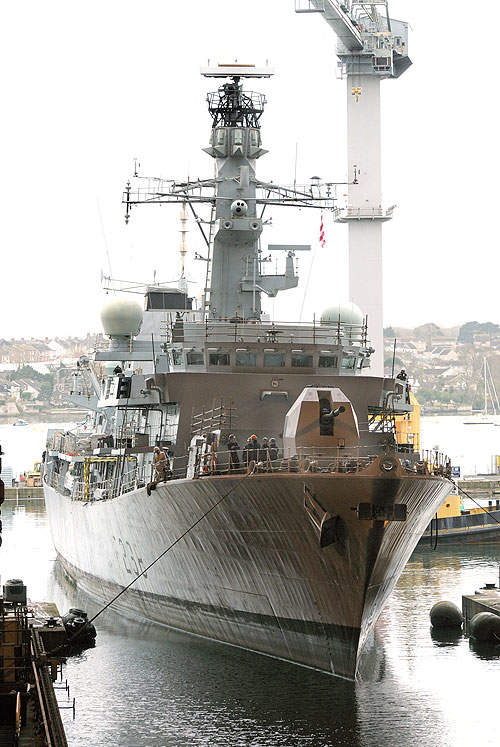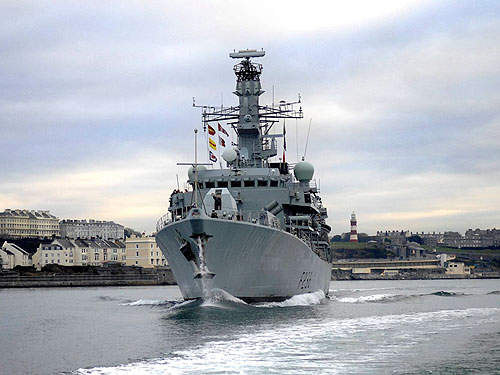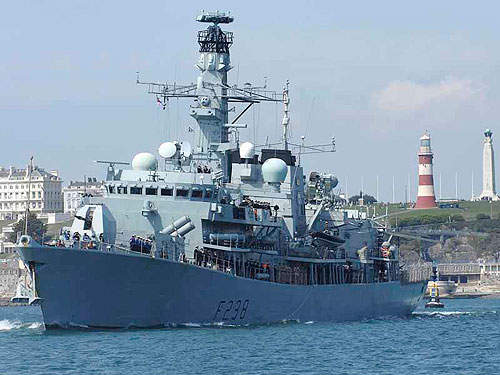HMS Northumberland is a Duke Class Type 23 frigate serving the UK’s Royal Navy. The warship was built at Swan Hunter’s shipyard at Wallsend and based at HMNB Devonport. The ship was launched in April 1992 and entered the service with the Royal Navy in May 1994.
The ship underwent its first refit in July 2004. The $36.1m, year-long programme was carried out by Babcock at its dockyard in Rosyth.
In March 2011, a second refit programme was launched to improve the ship’s sustainability and fighting capability. HMS Northumberland is scheduled to rejoin the fleet after completion of sea trials in December 2011.
Features
The ship is 133m long and 16.1m wide. It has a displacement of 4,900t and a top speed of approximately 28kt. The vessel is primarily an anti-submarine warship, but is equipped with a range of weapon systems, making it a highly versatile. It is expected to be taken out of service in 2029.
Programme
The second refit programme, scheduled to last nine months, was launched under the Surface Ship Support Alliance. The alliance includes the UK Ministry of Defence (MoD), Babcock and BAE Systems. Babcock will carry out the refit, which will see command systems, weapons, sonar and other onboard systems upgraded.
Nato radial filters will be installed on the ship to safeguard air supplies from contamination in case of an incident.
To ensure optimum condition of the service areas, the ship’s galley equipment will be upgraded, as will the vessel’s high-pressure air system — to isolate it from the high-pressure air ring main — and underwater inlets and outlets .
The maintenance programme will include a complete structural review of the ship and require the removal and replacement of several pieces of equipment, pipework and cables. A paint-preservation package is also part of the upgrade programme.
The commissioning phase will include integration of all of the ship’s weapons, sonar and radar units.
Command and control
All Duke Class frigates are equipped with the BAeSEMA command system. As part of the refit programme, a new DNA(2) command system will be installed on the ship. The Defence Information Infrastructure (Future) will also be installed to ensure collaborative working across the Armed Forces and the MoD.
The existing nuclear, chemical and biological incident surveillance system will be replaced with a state-of-the-art digital system. This new system will include fire and flood detection, and door / hatch status indication.
Sonar
HMS Northumberland is equipped a type 2050 bow sonar and a type 2031 towed sonar. Deep maintenance of the type 2050 sonar dome and array will be carried out under the refit programme. The port and starboard shafts and port-side main propulsion gear wheel will also be replaced.
Radar
The ship is equipped with type 1008 radar for navigation, a type 996 search radar and a two-type 911 shooting radar.
Weapons
HMS Northumberland is equipped with the Sea Wolf surface-to-air missile system, two quad-harpoon anti-ship missiles and DLF3 decoy launchers. During the 2004 refit, the ship was fitted with a 4.5in Mk8 gun, anti-submarine torpedoes and the S2170 surface ship torpedo defence system.
Under the current refit programme, the Sea Wolf mid-life update will be carried out to counter anti-ship missile threats. The update will include tracking, guidance and weapon management modifications. A new automatic, small-calibre gun will also be installed.
Propulsion
The ship features a combined gas turbine and gas turbine propulsion system comprising of two Rolls-Royce gas turbines, four Paxman diesel engines and two GEC electric motors.
Aircraft
Originally, the ship could only support the Mk8 Lynx combat helicopter. In the 2004 refit programme, the hangar and flight deck were upgraded to accommodate the Merlin helicopter.
Missions
HMS Northumberland was originally commissioned to strengthen UK’s security in the South Atlantic, around the Falkland Islands. The ship, however, has been more active in carrying out anti-arms and anti-people smuggling, counter-terrorism and piracy deterrence patrols. Since its launch, the ship has covered 91,904km on several such missions.
The ship was part of Operation CALASH, a multinational maritime task force formed to provide security in the Middle East, including the Gulfs of Aden and Oman, and the Somali coast. The vessel has been carrying out counter-piracy operations in these regions along with other warships of the Royal Navy.
It has also carried out humanitarian missions such as delivering aid to Somalia. It was also the first Royal Navy to escort UN World Food Programme ships along the Somalian coastline, where piracy attacks are high.






